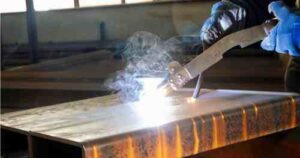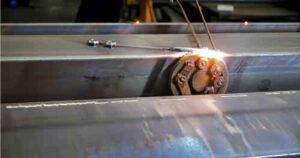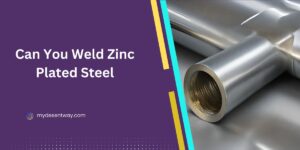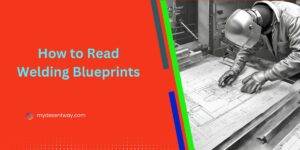Table of Contents
- 1. How to Start with JB Weld
- 2. Understanding Sanding
- 3. Sanding Techniques for JB Weld
- 4. Factors Affecting JB Weld Sanding
- 5. Practical Aspects of Sanding JB Weld
- 6. Challenges and Alternatives
- 7. Specific Queries and Concerns
- 8. Additional Considerations
- 9. How soon can you sand jb weld
- Conclusion
- FAQs – About Can You Sand JB Weld
Can you sand JB Weld? This query often arises among those seeking to modify or refine this versatile epoxy adhesive. Sanding JB Weld presents challenges and opportunities, prompting a quest for effective techniques and insights.
This article delves into the nuances of sanding JB Weld, exploring its possibilities, techniques, factors affecting the process, and alternative approaches. Discover the answers you seek regarding the salability of JB Weld and unlock a comprehensive guide to achieve desired finishes while preserving the integrity of this adhesive.
1. How to Start with JB Weld
What is JB Weld?
JB Weld is a versatile epoxy adhesive renowned for its exceptional bonding capabilities across various materials. Composed of resin and hardener, JB Weld sets as a durable and strong compound, capable of withstanding high temperatures and providing robust adhesion. Its widespread use in repairs, construction, automotive applications, and DIY projects stems from its reliability and adaptability.
Is JB Weld Sandable?
One common query among users revolves around the sandability of JB Weld. Sanding JB Weld involves refining its surface to achieve smoother finishes or specific shapes. However, the process isn’t straightforward due to JB Weld’s sturdy nature once cured. Yes, you can sand JB Weld after it has fully cured.
Understanding whether JB Weld is sandable and the techniques involved becomes crucial for those seeking to modify or refine its appearance for various applications.
JB Weld’s sandability depends on multiple factors, including the type of JB Weld used, the surface it’s applied to, and the desired outcome. Exploring this aspect further will illuminate the nuances of sanding this epoxy adhesive and the best practices to achieve desired results without compromising its integrity.
2. Understanding Sanding
Explanation of Sanding
Sanding is a process used to refine surfaces by abrading them with abrasive materials, like sandpaper. Its primary goal is to smooth rough surfaces, remove imperfections, or shape materials to desired contours. For JB Weld, sanding is crucial in altering its appearance, refining its texture, or preparing it for subsequent applications, such as painting.
Dry Sanding vs. Wet Sanding
Dry Sanding: Involves using sandpaper or abrasive materials on a dry surface. It’s efficient for initial rough shaping or removing excess material from JB Weld. However, it can generate dust, which requires careful handling to prevent inhalation and ensure a clean working environment.
Wet Sanding: Utilizes water or a lubricating liquid while sanding. This method minimizes dust production, provides a better surface finish, and prevents sandpaper clogging. Wet sanding JB Weld is often preferred for its smoother results and reduced risk of damaging the epoxy’s surface.
Both techniques have their merits, and the choice between dry and wet sanding depends on the specific requirements of the project and the desired finish.
Understanding these sanding methods is crucial before delving into the nuances of sanding JB Weld. Each technique has advantages and limitations, impacting the overall outcome and the efficiency of modifying JB Weld’s surface.
3. Sanding Techniques for JB Weld
Sanding JB Weld Clear Epoxy
JB Weld Clear Epoxy, known for its transparency, presents unique challenges regarding sanding. Its explicit nature demands precise sanding techniques to maintain transparency while achieving the desired finish. Using fine-grit sandpaper, preferably above 400 grit, in a gentle, circular motion helps gradually refine the surface without clouding or distorting its transparency.
Sanding JB Weld Steel Stick
Unlike the clear epoxy, JB Weld Steel Stick contains metal filler and necessitates a slightly different approach to achieve optimal results. Coarser sandpaper, around 120 to 220 grit, can smoothen the surface without compromising its durability. However, cautious sanding is crucial to prevent the removal of excessive filler material, which might affect its structural integrity.
Materials Required for Sanding
For sanding JB Weld, gather essential materials:
- Sandpaper with various grits (ranging from coarse to fine)
- Water and a container (if opting for wet sanding)
- Protective gear (such as goggles, a mask, and gloves)
- Cloth or sponge for cleaning
Selecting the appropriate sandpaper grit depends on the specific type of JB Weld and the intended finish. Coarser grits are suitable for initial shaping or removing excess material, while finer grits provide smoother finishes.
4. Factors Affecting JB Weld Sanding
Different Surface Considerations
Sanding JB Weld can vary based on the surface it’s applied to. Various materials, such as metals, plastics, or wood, can react differently to sanding techniques. Understanding the surface material is crucial as it impacts the adherence of JB Weld and how it responds to sanding. Metals might require more abrasive sanding than plastics or wood to achieve the desired smoothness.
Impact of Heat and Chemicals
JB Weld’s resilience results from its resistance to high temperatures and chemicals once cured. However, excessive heat or exposure to certain chemicals can affect its sandability. Extreme heat might soften the epoxy, making it more susceptible to damage during sanding. Similarly, certain chemicals can alter the epoxy’s composition, making it challenging to achieve desired results through sanding.
Recognizing the influence of these factors on JB Weld’s sanding process is essential for effective modifications. Proper surface assessment and understanding of the potential impact of heat and chemicals aid in employing suitable sanding techniques without compromising the integrity of the epoxy adhesive.
5. Practical Aspects of Sanding JB Weld
Step-by-Step Guide to Sanding JB Weld
-
Preparing the Surface
Before initiating the sanding process, ensure the JB Weld surface is clean and debris-free. Use a gentle cleanser and allow it to dry completely before sanding.
-
Choosing the Right Grit
Select appropriate sandpaper grit based on the specific JB Weld variant and the desired finish. Coarser grits are suitable for initial shaping, while finer grits offer smoother finishes.
-
Sanding Technique
Apply even pressure while sanding in a circular or back-and-forth motion, depending on the desired outcome. For clear epoxy, employ gentle, circular motions to maintain transparency.
-
Tips for Successful JB Weld Sanding
- Patience: Avoid rushing the process; gradual sanding yields better results.
- Check Progress: Periodically check the surface to ensure desired smoothness without over-sanding.
- Safety Measures: Wear protective gear to avoid inhaling dust and to protect skin.
-
How Long Until You Can Sand JB Weld?
The curing time for JB Weld varies based on factors like temperature and humidity. Refer to the product instructions for specific curing durations before initiating the sanding process. Typically, allowing JB Weld to cure for 24 hours ensures optimal hardness for sanding.
Understanding these practical aspects of sanding JB Weld empowers individuals to execute the process effectively, achieving desired finishes without compromising the structural integrity of the epoxy adhesive.
6. Challenges and Alternatives
Pros and Cons of JB Sanding
Pros:
- Refinement: Sanding offers the ability to refine JB Weld’s appearance and texture for specific applications.
- Surface Preparation: Smooth surfaces obtained through sanding are conducive to painting or subsequent bonding.
Cons:
- Potential Damage: Incorrect sanding techniques can compromise JB Weld’s integrity.
- Time-Consuming: Achieving desired finishes might require multiple stages of sanding.
Common Mistakes to Avoid
- Rushing the Process
Sanding JB Weld requires patience. Rushing through the process might lead to uneven surfaces or even damage to the epoxy.
- Using the Wrong Grit
Inappropriate grit selection can result in inefficient sanding or unintentional excessive material removal.
- Neglecting Safety Measures
Ignoring safety gear can lead to health hazards due to dust inhalation or skin exposure to abrasive particles.
Alternative Finishing Methods
Apart from sanding, alternative methods like polishing or using specialized abrasives offer options to achieve desired finishes on JB Weld surfaces. Compounds or specific polishing tools can refine surfaces without relying solely on sanding techniques.
7. Specific Queries and Concerns
Can JB Weld be Ground or Filed?
JB Weld’s robust nature allows for limited grinding or filing, especially when dealing with excess or unwanted material. However, caution is crucial to prevent compromising the structural integrity of the epoxy.
Shaping JB Weld and its Paintability
Shaping JB Weld can be achieved through careful sanding or moulding while pliable before complete curing. Once cured, JB Weld can be painted after proper surface preparation and sanding to ensure adhesion and a smooth finish.
Is JB Water Weld Sandable?
JB Water Weld shares sandability properties with other JB Weld variants. However, due to its different composition, specific considerations should be made based on the surface and intended application.
Why JB Weld Might Not Harden?
Several factors can affect JB Weld’s curing and hardening:
- Improper Mixing: Inaccurate mixing ratios can hinder proper curing.
- Temperature and Humidity: Extreme conditions can affect the curing process.
- Old or Expired Product: Using an expired JB Weld can impede its hardening ability.
Addressing these specific queries and concerns about grinding, shaping, paintability, and curing issues ensures a more comprehensive understanding of JB Weld’s properties and the intricacies involved in its application and modification.
8. Additional Considerations
Can JB Weld be Painted After Sanding?
Sanding JB Weld creates a smoother surface conducive to paint adhesion. However, proper surface preparation, including thorough cleaning and using appropriate primers, is essential for ensuring that the paint adheres effectively to the sanded JB Weld surface. Once sanded and prepared, applying paint should yield satisfactory results.
Does Sanding JB Weld Release Harmful Fumes?
Sanding JB Weld can generate dust particles, but the epoxy itself, when cured, generally does not release harmful fumes. Nonetheless, wearing appropriate respiratory protection and working in a well-ventilated area is advisable to minimize potential exposure to airborne particles during sanding.
Outdoor Applications with JB Weld
JB Weld’s resistance to temperature variations and weathering makes it suitable for some outdoor applications. However, ensuring proper surface preparation, application techniques, and adequate protection against environmental elements are crucial for its longevity in outdoor settings.
Understanding these additional considerations surrounding JB Weld’s post-sanding paintability, potential fumes, and suitability for outdoor applications provides users with comprehensive knowledge, enabling them to make informed decisions regarding JB Weld usage in various scenarios.
9. How soon can you sand jb weld
You can typically sand the JB Weld after it has fully cured, which usually takes about 4-6 hours at room temperature. However, for best results, allowing it to cure for at least 24 hours before sanding is recommended to ensure it’s fully hardened. This ensures that it will be easier to sand and will provide a smoother finish.
Conclusion
In conclusion, the question, Can you sand JB Weld? has been addressed by exploring techniques, considerations, and alternatives. Sanding JB Weld requires precision, understanding surface variations, and employing appropriate methods to achieve desired results.
With insights into its sandability, factors impacting the process, and alternative finishing approaches, readers can confidently navigate modifying JB Weld while preserving its strength and functionality. Embrace the possibilities, armed with knowledge, to refine JB Weld effectively for diverse applications.
FAQs – About Can You Sand JB Weld
Can JB Weld be sanded for a smoother finish?
Yes, using proper techniques and sandpaper, JB Weld can be sanded to achieve a smoother surface or specific shapes.
Does sanding JB Weld compromise its strength?
When done correctly, sanding typically doesn’t compromise JB Weld’s strength. It’s crucial to follow recommended procedures.
What sanding method works best for JB Weld?
Both dry and wet sanding methods can work for JB Weld. Wet sanding often produces smoother results and less dust.
Can I paint over JB Weld after sanding?
Yes, after sanding JB Weld, proper surface preparation allows for successful painting, ensuring good adhesion and a refined finish.
Does sanding JB Weld release harmful fumes?
Sanding JB Weld can produce dust particles, but cured JB Weld generally doesn’t release harmful fumes. However, proper safety precautions are recommended.











3 thoughts on “Can You Sand JB Weld?”